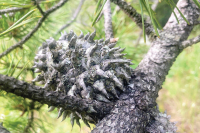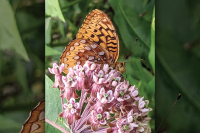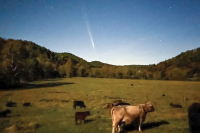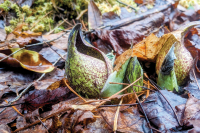Restoring a giant: EBCI partners to resurrect the chestnut tree
 This still-healthy American chestnut tree growing wild in Western North Carolina bursts with nut-filled burs. TACF photo
This still-healthy American chestnut tree growing wild in Western North Carolina bursts with nut-filled burs. TACF photo
Rex Mann’s father was the kind of storyteller whose voice would make everyone in the room stop what they were doing, come and listen.
“In many of his stories, he’d talk about this special tree, the American chestnut, and what it meant to his people,” Mann told the Eastern Band of Cherokee Indians’ Timber and Natural Resources Committee last August. “His voice would be animated, and he would say, ‘The wood of the chestnut was amazing. It lasted forever. It was slow to rot. The chestnut fed our livestock, the game we hunted, and us. We never had any money, so in the fall the whole family would gather chestnuts by the sackful and carry them to the country store, where we swapped them for things we had no money to buy, like shoes for the kids.’
“Then he added, ‘But that was before the blight.’”
Mann, director emeritus for Asheville-based The American Chestnut Foundation, grew up in Kentucky hundreds of miles away from the forests of Western North Carolina. But the same towering chestnut trees that formed the backbone of his native hills once covered these mountains too. And the same fungal blight killed them both.
The chestnut blight, accidentally imported from Asia, was first observed in New York City in 1904. It spread like wildfire, and by the 1950s there were no mature chestnut trees to be found in the 200 million acres that once housed an estimated 4 billion of them. Because the blight kills only the above-ground portion of the tree, American chestnuts still exist in the wild, but only as shrubs sprouting from the stumps of fallen giants, doomed to die long before they touch the sky.

Related Items
Accompanied by EBCI Secretary of Agriculture and Natural Resources Joey Owle (left) and TACF Director Emeritus Rex Mann (right), Vice Chief Alan “B” Ensley and TACF Director and CEO Lisa Thompson sign the memorandum of understanding April 21. TACF photo
Partnership with Cherokee
Since 1983, TACF has been working to reverse that fate, and the Eastern Band of Cherokee Indians is poised to become a key player in the effort.
“We’re just getting started, and it’s exciting to think about the research opportunities that are going to go on after we’re gone from here,” said EBCI Secretary of Agriculture and Natural Resources Joey Owle.
Mann came to Cherokee at the invitation of Painttown Representative Dike Sneed, whose father Jimbo and Mann’s late father were fast friends, united by their calling as Baptist ministers. Mann was eager to share his life’s work — restoring the chestnut tree — with these family friends whose culture and way of life have also been impacted by the chestnut’s disappearance.
On April 21, atop a pristine mountain on tribal reserve land in the area of Cherokee’s Wolfetown community, the tribe and the nonprofit signed a memorandum of understanding for a four-phase partnership to establish a demonstration orchard for a blight-resistant form of the chestnut tree on tribal lands. For more than 30 years, TACF has been working to develop an American chestnut tree capable of withstanding the blight’s ravages and reclaiming its place in the forest canopy.
That’s no longer a far-off goal. Within a decade, efforts could begin to plant chestnuts throughout their historical range.
It’s “overwhelming,” said Samantha Bowers, director of philanthropy and external affairs for TACF, to think that in as little as five to 10 years, “we will have the true answer to, ‘Are we ready to gear up our production and get this restoration show on the road?’”
The trees about to get planted in the 4-acre demonstration orchard established with the MOU are the product of a project TACF has had ongoing since 1989. The trees are seventh-generation backcrosses with the Chinese chestnut tree, which does not succumb to the blight like its American cousin. The backcrosses are created by breeding a Chinese chestnut tree with an American chestnut, then breeding the hybrid offspring with another American chestnut, and breeding that offspring with an American chestnut — and so on, until producing a hybrid tree that retains the Chinese blight resistance but in every other way presents as the American species.
The 25 trees that TACF donated for the Cherokee partnership are fifteen-sixteenths American chestnut, and just one-sixteenth Chinese. They’re blight-resistant but grow like the American species — though it remains to be seen if any characteristics associated with the Chinese species come out as the trees get older.
Under the first phase of the partnership, the EBCI will get the orchard established, which includes working out a site design and taking exacting care of the transplanted trees to ensure successful establishment for as many as possible.
In the second phase, the tribe will gather genetic material from at least 20 American chestnuts from the Qualla Boundary and surrounding area for grafting into the orchard’s disease-resistant chestnuts. This will improve the genetic diversity of the blight-resistant stock, giving the species more genetic tools to survive — and hopefully thrive — in the wild.
The third phase will involve controlled pollinations between disease-resistant and wild chestnuts conserved by the EBCI, and a seed orchard will be established with this regionally adapted material. Finally, in phase four, the partnership seeks to repopulate the Qualla Boundary with disease-resistant American chestnuts harvested from EBCI orchards.
TACF already has partnerships in place allowing chestnut plots in locations across the tree’s native range, but this year the organization will apply for grants with the U.S. Forest Service to fund landscape-scale restoration trials on national forest lands in six or possibly seven states — North Carolina, Tennessee, Virginia, Kentucky, Pennsylvania, Maine, and maybe Georgia.
“These will take about five to 10 years for us to monitor, and with successful results that we’re hopeful for, we’ll be able to deem that the chestnuts we have to date are ready to compete in the forest environment,” said Bowers.
Multiple approaches
The hybrid backcross project is the longest-running in the effort to restore the chestnut, but it’s just one of three approaches scientists are now studying.
At the State University of New York College of Environmental Science and Forestry, researchers have inserted a single wheat gene to create a genetically modified chestnut tree that can coexist with the fungus that wiped out its ancestors. The wheat gene creates an enzyme that breaks down the acid the chestnut blight fungus produces, rendering it harmless. It’s an exciting development, because while the seventh-generation backcross tree contains more than 10,000 genes that originate from the Chinese chestnut, the transgenic tree from SUNY contains only one gene that does not come from the American chestnut.
“This is going to be a pure American chestnut in all its characteristics,” said Bowers. “That’s a very exciting potential there.”
Meanwhile, scientists at the University of Maryland and West Virginia University are studying the biocontrol method of blight protection. This approach uses a virus to weaken the chestnut blight fungus, allowing the tree to survive infection.
These two approaches are much more heavily regulated than the hybridization method that TACF has been using for decades. Before transgenic chestnut trees or biocontrol organisms can be released out into the world, researchers must gain approval from the U.S. Department of Agriculture, Environmental Protection Agency and Food and Drug Administration, all of which require public comment periods as part of the process. Bowers estimates it will take about two more years for the federal government to give its answer on the transgenic tree and three to four years on use of the biocontrol method.
The partnership between the EBCI and TAFC could eventually include use of these more cutting-edge approaches. However, any use of transgenic trees or biocontrol would occur years in the future. For now, the tribe is just planting hybrid trees and working to engage its members in the effort.
“That’s going to be years down the road before we even consider taking a look at those opportunities,” said Owle.

Before the blight, American chestnuts were once a staple in the diets of people, wildlife and livestock. TACF photo
Blueprint for the future?
These newer approaches — especially the transgenic approach — have ignited some controversy among environmental advocates. Even as some organizations like TACF hail the transgenic tree as a vital tool in the quest to restore a native species, others decry it as a dangerous alteration of the natural order that’s being considered without research into its potential long-term effects. During a virtual press conference held in October, leaders of five organizations opposing the transgenic tree spoke on the subject, including B.J. McManama of the Indigenous Environmental Network.
“Today, there remain large areas of traditional and treaty lands on which much is forested and managed as sovereign territory of many different Native American peoples,” she said in a press release. “These forests are not only a source of economic self-determination but hold great cultural significance to include sacred sites where the trees are an element of sustenance, knowledge and familial identity. Every living being within the forests are related in some form, and nothing within these lands lives in isolation, therefore changing or altering the original instructions of any one or any part of these elements threatens the natural order established over millennia.”
Bowers acknowledged that there’s no way to answer the question about long-term effects right now, but said that to save the chestnut “we have to be willing to take that risk.”
It will take all three tools — hybridization, gene modification and biocontrol — to successfully restore a tree that once composed a quarter of the Appalachian hardwood population, said Bowers.
Saving the chestnut impacts far more than just that one species.
“We must understand that everything that lives in these mountains is interconnected,” said Mann. “Everything affects each other. When we lose a species, it rips a hole in the fabric of the ecosystem that never recovers in our lifetime. Other trees will take over the space where the dead trees once grew, but they can never play the role that the original trees played.”
SUNY researchers have run a number of experiments to investigate the transgenic tree’s impact on a wide range of species, including wood frog tadpoles. For the last century, tadpoles have been able to feed only on maple and beech leaves, but SUNY researchers found that their growth rate increased when they fed on American chestnut leaves, whether transgenic or wild. If tadpoles across the eastern U.S. could once more access these more nutritious leaves, what ripple effects might emanate up and down the food chain?
“It makes you think that nature misses the chestnut more than we even know,” said Bowers.
While TACF’s focus thus far has been exclusively on restoring the chestnut, the organization sees its work as creating a blueprint for future restoration of the myriad native tree species now under attack from invasive pests. Since the death of the chestnut, disease has devastated the American elm and the white walnut. The emerald ash borer is now killing ash trees by the billions, and the hemlock wooly adelgid is well on its way to taking out the eastern hemlock, along with the shade these trees provide to mountain trout streams. Emerging diseases threaten black walnuts and oak trees.
In his speech to the Timber and Natural Resources Committee, Mann said that, without using cutting-edge science to save them, those trees are doomed. He compared the choice before today’s leaders to the one he faced years ago when a doctor diagnosed him with Stage 4 Hodgkin Lymphoma. He had to choose whether to seek treatment or let nature take its course. He chose treatment, which led to remission.
“We’ve made significant progress in restoring the chestnut tree,” he said. “The tree will be restored, but perhaps even more importantly, by doing so we are blazing a trail for using cutting-edge science to restore the other trees that we are tragically losing.”













